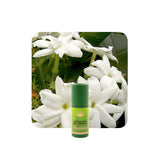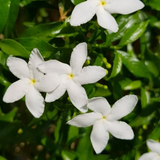Alambika 亞拉伯小花茉莉原精 Jasmine arab. (Sambac) Absolute
Botanical name: Jasminum sambac
Quality: 100% natural essential oil
Cultivation: obtained by extraction
Suitability as: commodity
Fragrance Profile: Fragrance Notes: Heart
Plant part: flowers
Origin: India
Product notice: main
Chemotypes: (INCI) Benzyl acetate, Linalool, Benzyl benzoate, cis-3-Hexenyl benzoate, Benzyl alcohol, Methyl anthranilate
USE
Jasmine, the "Queen of the Night" has something infinitely gentle, calming and liberating. The essential oil of the plant is one of the essential "rescue oils" and can be extremely helpful in sudden shock. It is not surprising that its scent is appreciated in so many perfumes. Jasmine calms the nerves, relaxes the mind and dissolves mental tension and anxiety. Jasmine has a mood-enhancing effect, relieves stress and relieves tension.
It helps us to recognize and let go of entrenched behaviors and thought patterns. Jasmine gives us inspiration, self-confidence and euphoria for new paths. In relationships, too, it can help to promote trust and devotion to our partner (and ourselves). It has an aphrodisiac effect and helps to release blockages and let us go.
For a sensual, uplifting atmosphere: add 1-2 drops to your diffuser.
ABOUT THE PLANT
Jasmine is a climbing tree or shrub from the olive tree family. The plant originally comes from the Himalayas and China, but is now cultivated in many tropical and subtropical countries worldwide.
Its star-shaped, white flowers have an intense, beguiling floral scent that conveys sensuality, eroticism and femininity. In China and the Orient, the aromatic substances of jasmine have been used for tea flavoring and for the production of perfume for thousands of years.
1000 kg of jasmine flowers are required for 1 kg of absolute obtained by hexane extraction. The main ingredients of jasmine are various esters, which play an important role in aromatherapy, since their properties are described as being skin-friendly and mentally and physically relaxing. Jasmine is considered mood-enhancing,
Article number: 1635




